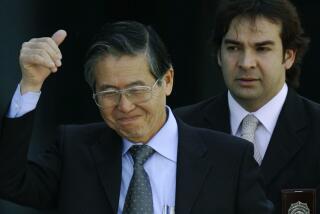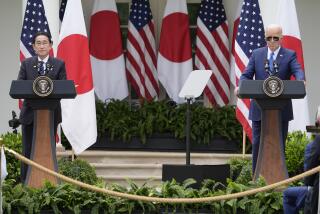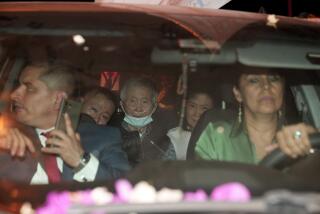Leaders of Peru, Japan to Meet in Canada on Hostage Crisis
LIMA, Peru â Peruvian President Alberto Fujimori will meet with Japanese Prime Minister Ryutaro Hashimoto in Toronto this weekend to discuss the crisis here at the Japanese ambassadorâs residence where rebels hold 72 hostages, officials said Wednesday.
The announcement by Education Minister Domingo Palermo, Peruâs designated negotiator in the hostage crisis, came after expressions of concern over the last few days by Hashimoto and other Japanese officials about aggressive Peruvian police maneuvers around the barricaded mansion.
After weeks of little progress in efforts to end the 44-day standoff, the decision suggests that Japan wants to push for a peaceful solution.
âPresident Fujimori has told us he wants to discuss the Peruvian situation with me as soon as possible,â Hashimoto told reporters in Japan.
A Japanese government spokesman in Lima said the meeting is âa mutual decisionâ by the two governments. Palermo said it will be held Saturday morning.
Toronto is a logical site because the Canadian ambassador to Peru, former hostage Anthony Vincent, belongs to the commission of âguarantorsâ created to monitor talks between the barricaded rebels of the Tupac Amaru Revolutionary Movement and the Peruvian government.
The mediating commission also includes Palermo and representatives of the International Committee of the Red Cross and the Roman Catholic Church.
In an apparent response to escalating tension between rebels and police, the mediating commission met Tuesday in Lima with Fujimori and a Japanese diplomat monitoring the crisis here.
Afterward, Palermo said Peru was studying a larger role for Japan in resolving the crisis and emphasized that the besieged residence enjoys diplomatic âinviolability.â
The incident that prompted those reassuring words erupted Monday when a barricaded rebel opened fire on police from inside the mansion.
What may have been the most dangerous moment in the siege since the rebels stormed the residence Dec. 17 occurred as hundreds of police commandos in armored personnel carriers then paraded around the diplomatic compound. A portable sound system blared military marches, part of a continuing campaign of psychological warfare.
When police in one of the armored personnel carriers flashed obscene hand gestures at the mansion, a rebel--reportedly one of two women among the estimated 17 guerrillas--fired four shots, authorities said. Televised images showed a puff of smoke kicked up by bullets that apparently hit the vehicle within inches of the police officers, who ducked inside the vehicle.
Police took cover in combat positions but did not return fire.
Still, the gunfire has echoed in this city for days, as observers say both sides reached the brink of a violent confrontation.
âThey shot to kill,â said Hector Jhon, a former police general in charge of anti-terrorist operations and a current Lima city councilman. âIt shows the Tupac Amaru are aggressive and show little value for human life.â
The shooting shows that the siege has worn on the nerves of the Tupac rebels, most of whom are younger than 25, Jhon said.
But he also said in an interview that the police officers who made the obscene gestures in full view of television cameras were âinept and irresponsible.â
The government has said the shows of force by the police--with simulated commando charges and swooping helicopters--are a justified tightening of a secure perimeter.
But critics say the police seem intent on provoking a violent reaction. They say hard-line elements of the government are urging a tough response. The hard-liners, critics say, may have even pushed authorities recently to criticize Red Cross mediators, whom government officials and their allies in the Congress and press say have been overly favorable to the Tupac Amaru.
âIt is hard to understand how the show of force [by authorities] . . . including shameful obscene gestures, could intimidateâ the rebels, wrote columnist Santiago Pedraglio on Wednesday in the newspaper Gestion. âThe only ones who really suffer are the hostages and their families.â
The Japanese apparently feel the same way. Departing from their cautious tone, high-ranking officials have expressed concern about the welfare of the hostages this week.
More to Read
Sign up for Essential California
The most important California stories and recommendations in your inbox every morning.
You may occasionally receive promotional content from the Los Angeles Times.









